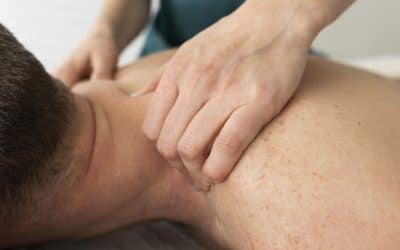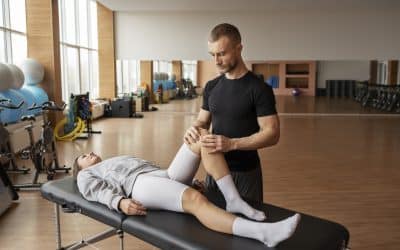Updated 15/10/2015
Do you usually sit all day long? If so, you’ve probably already realised that sitting isn’t good for your body. Many of our clients have jobs that involve sitting at a desk for most of the day. That’s the case for most people. They may find themselves hunching over their computer keyboard for up to eight hours or more a day, five days a week. All those hours of hunching over can have a negative impact on their posture.
Many workers who sit at desks most of the day have rounded shoulders from slouching at their workstations. They regularly work at their computers with extended necks and may even sit twisted, with their computer screens facing one way and their mice positioned in the opposite direction. Does this sound like you? If so, do you usually continue slouching during your breaks and lunches? Years of slouching can take a toll.
The good news is that sitting hunched or slouched is reversible. You may not realise that slouching forward causes your chest muscles to shorten and tighten, pulling your shoulders forward. The muscles in your upper back then overwork to try to pull your shoulders into their correct alignment. This causes your shoulders to tighten, too. When your neck and spine are in a forward position, your shoulders are rotated inwards, causing the muscles in your lower back to work and activate when they normally wouldn’t. They work to keep the spine upright. All of this can cause negative postural issues and pain.
We’ve put together some simple, effective exercises you can do to relieve tightness in your chest, strengthen your back & neck, and beat the pain and discomfort that go with static posture. It’s essential to do these exercises at least once a day, though twice a day is better. Do them once before your lunch break and again before you head home.
Before we get to the exercises, we’ll look at static posture and what it is.
What is Static Posture?
Static posture is the condition of staying in the same posture or position for long periods, usually during work. This condition can reduce blood flow and cause muscle damage. Static posture can also affect the nerves, ligaments, blood vessels, and tendons.
The condition is most often found in jobs that require employees to remain in one position for long periods. The result is aching muscles, back pain, leg cramps, and more. It’s also possible for this condition to cause damage to ankles, knees, and hip joints.
It’s not uncommon for patients to also experience severe pain in their wrists, hands, elbows, forearms, neck, and shoulders. The pain and discomfort of static posture can make doing daily tasks even more challenging.
Effects of Static Posture
Any occupations that require prolonged sitting or standing that also include repetitive movements can cause pain and fatigue. In addition, the back, shoulders, neck, legs, and wrists can experience stiffness and discomfort depending on the posture, work hours, and level of exertion.
Prolonged Sitting & Health Risks
Sitting for several hours during the day can result in certain health risks, including:
- Reduced blood flow
- Pain
- Degeneration of spinal discs
- Neck & shoulder pain
- Back pain
- Muscle degeneration
- Osteoporosis
Prolonged Standing & Health Risks
Prolonged sitting can also increase the development of the following health risks:
- Varicose veins
- Heel problems
- Leg/knee pain
- Hip pain
- Foot pain
Simple Exercises to Relieve Static Posture Symptoms
Here are some simple, effective exercises you can do to relieve static posture symptoms. These exercises relieve chest tightness, strengthen your back & neck, and relieve pain & discomfort. The exercises should be performed at least once a day, though twice a day is recommended. You could do the exercises before your lunch break and just before going home.
1. Neck Stretch
This exercise helps lengthen and strengthen your neck muscles. They make it easier to hold your neck in the right position when sitting at your desk/computer.
- Stand with feet hip-width apart and put your hands on your hips.
- Keep your shoulders pulled back and squeeze your shoulder blades together.
- Tilt your chin as far forward as possible—give yourself a double chin.
- Hold for 10 seconds, release, and try again.
Repeat this exercise 3 times.
2. Chest Stretch
This exercise opens the chest and relieves tightness caused by rounded shoulders.
- Stand in an open doorway and put your forearms on each side of the door frame.
- Position your elbows at 90 degrees and stand square through the doorway.
- Lean your chest through the open doorway, feeling the stretch across your chest.
- Hold for 30 seconds, rest, and repeat.
Repeat this exercise 2 times.
3. Upper Back Foam Rolling
This exercise targets the upper back, specifically the area between your shoulder blades. It helps to open up your chest. As you roll across a tight area, hold the pressure there until you feel the tension release. If it’s not appropriate to roll on a foam roller during office hours, do this exercise at home.
4. Back Extension
This exercise works to stretch your chest and strengthen your entire back.
- Lie on the floor, face down.
- Keep your legs and arms straight, with your arms off the ground, and palms facing down.
- Bend at the elbows and pull your arms back, squeezing your shoulder blades together.
- Hold your chest off the floor and perform this forward/backward movement 10-15 times, slowly and controlled.
5. Wall Glide
This exercise improves the alignment of your back, neck, and shoulders from the pelvis.
- Stand with your back against a wall with your heels, buttocks, shoulder blades, and head all in contact with the wall.
- Position the backs of your arms on the wall with your elbows at 90 degrees, upper arm parallel to the floor.
- Slowly glide your arms and the backs of your hands up to the wall, reaching towards a straight arm.
- The minute your elbows or the back of your hands come away from the wall, stop and hold this position.
- Try not to engage the neck muscles to aid movement. Keep your shoulders relaxed and down.
- Do a slow glide three times, returning to the start position each time.
Summing It Up
The good news is that these five exercises don’t take long—you only need to dedicate about 5 minutes to them twice a day! Your back and neck will enjoy the stretching and strengthening. You may also find that you’re more comfortable when working, with less pain, too!
FAQs (Frequently Asked Questions)
Can I relieve pain from static posture without buying expensive ergonomic equipment?
Yes, simple adjustments like stretching, proper posture, and regular breaks can make a significant difference.
How often should I take micro breaks?
Aim for a 1-2 minute micro break every 30 minutes to an hour.
Can yoga really help with pain relief?
Absolutely! Many yoga poses and stretches can target areas prone to discomfort.
Are there any long-term health risks associated with prolonged static posture?
Yes, it can lead to chronic issues if not addressed, such as musculoskeletal problems and reduced mobility.
What’s the best way to remind myself to take breaks?
You can set a timer or use apps designed to remind you to stand up and move around.
Can I incorporate these techniques into my workday, even at the office?
Certainly! Most of these tips are easy to implement at your desk.







